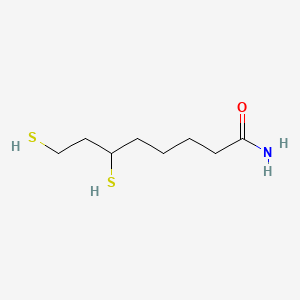| MeSH term | MeSH ID | Detail |
|---|---|---|
| Parkinsonian Disorders | D020734 | 20 associated lipids |
Dihydrolipoamide
Dihydrolipoamide is a lipid of Fatty Acyls (FA) class. Dihydrolipoamide is associated with abnormalities such as Wiskott-Aldrich Syndrome. The involved functions are known as Citric Acid Cycle, Electron Transport, NADH oxidation, Oxidation and Oxidants. Dihydrolipoamide often locates in Mitochondria, Mitochondrial matrix and Chloroplasts. The associated genes with Dihydrolipoamide are Mutant Proteins, Recombinant Proteins, mycothione reductase, Genes, Mitochondrial and alanylproline.
Cross Reference
Introduction
To understand associated biological information of Dihydrolipoamide, we collected biological information of abnormalities, associated pathways, cellular/molecular locations, biological functions, related genes/proteins, lipids and common seen animal/experimental models with organized paragraphs from literatures.
What diseases are associated with Dihydrolipoamide?
Dihydrolipoamide is suspected in and other diseases in descending order of the highest number of associated sentences.
Related references are mostly published in these journals:
| Disease | Cross reference | Weighted score | Related literature |
|---|
Possible diseases from mapped MeSH terms on references
We collected disease MeSH terms mapped to the references associated with Dihydrolipoamide
PubChem Associated disorders and diseases
What pathways are associated with Dihydrolipoamide
There are no associated biomedical information in the current reference collection.
PubChem Biomolecular Interactions and Pathways
Link to PubChem Biomolecular Interactions and PathwaysWhat cellular locations are associated with Dihydrolipoamide?
Visualization in cellular structure
Associated locations are in red color. Not associated locations are in black.
Related references are published most in these journals:
| Location | Cross reference | Weighted score | Related literatures |
|---|
What functions are associated with Dihydrolipoamide?
Related references are published most in these journals:
| Function | Cross reference | Weighted score | Related literatures |
|---|
What lipids are associated with Dihydrolipoamide?
There are no associated biomedical information in the current reference collection.
What genes are associated with Dihydrolipoamide?
Related references are published most in these journals:
| Gene | Cross reference | Weighted score | Related literatures |
|---|
What common seen animal models are associated with Dihydrolipoamide?
There are no associated biomedical information in the current reference collection.
NCBI Entrez Crosslinks
All references with Dihydrolipoamide
Download all related citations| Authors | Title | Published | Journal | PubMed Link |
|---|---|---|---|---|
| Sahlman L and Williams CH | Lipoamide dehydrogenase from Escherichia coli. Steady-state kinetics of the physiological reaction. | 1989 | J. Biol. Chem. | pmid:2498307 |
| Brautigam CA et al. | Structural and thermodynamic basis for weak interactions between dihydrolipoamide dehydrogenase and subunit-binding domain of the branched-chain alpha-ketoacid dehydrogenase complex. | 2011 | J. Biol. Chem. | pmid:21543315 |
| Hall BS et al. | Nifurtimox activation by trypanosomal type I nitroreductases generates cytotoxic nitrile metabolites. | 2011 | J. Biol. Chem. | pmid:21345801 |
| Vaubel RA et al. | Mutations in the dimer interface of dihydrolipoamide dehydrogenase promote site-specific oxidative damages in yeast and human cells. | 2011 | J. Biol. Chem. | pmid:21930696 |
| Islam MM et al. | A novel branched-chain amino acid metabolon. Protein-protein interactions in a supramolecular complex. | 2007 | J. Biol. Chem. | pmid:17314104 |
| Foster MW and Stamler JS | New insights into protein S-nitrosylation. Mitochondria as a model system. | 2004 | J. Biol. Chem. | pmid:15069080 |
| Petrat F et al. | Reduction of Fe(III) ions complexed to physiological ligands by lipoyl dehydrogenase and other flavoenzymes in vitro: implications for an enzymatic reduction of Fe(III) ions of the labile iron pool. | 2003 | J. Biol. Chem. | pmid:12963736 |
| Pessach I et al. | Essential requirement of cytosolic phospholipase A(2) for stimulation of NADPH oxidase-associated diaphorase activity in granulocyte-like cells. | 2001 | J. Biol. Chem. | pmid:11432850 |
| Argyrou A et al. | Characterization of a new member of the flavoprotein disulfide reductase family of enzymes from Mycobacterium tuberculosis. | 2004 | J. Biol. Chem. | pmid:15456792 |
| Rocheleau JV et al. | Quantitative NAD(P)H/flavoprotein autofluorescence imaging reveals metabolic mechanisms of pancreatic islet pyruvate response. | 2004 | J. Biol. Chem. | pmid:15148320 |
| Hiromasa Y et al. | Organization of the cores of the mammalian pyruvate dehydrogenase complex formed by E2 and E2 plus the E3-binding protein and their capacities to bind the E1 and E3 components. | 2004 | J. Biol. Chem. | pmid:14638692 |
| MacDonald MJ et al. | Immunochemical identification of coenzyme Q0-dihydrolipoamide adducts in the E2 components of the alpha-ketoglutarate and pyruvate dehydrogenase complexes partially explains the cellular toxicity of coenzyme Q0. | 2004 | J. Biol. Chem. | pmid:15075342 |
| Sundquist AR and Fahey RC | The novel disulfide reductase bis-gamma-glutamylcystine reductase and dihydrolipoamide dehydrogenase from Halobacterium halobium: purification by immobilized-metal-ion affinity chromatography and properties of the enzymes. | 1988 | J. Bacteriol. | pmid:3136140 |
| Gao H et al. | The E1beta and E2 subunits of the Bacillus subtilis pyruvate dehydrogenase complex are involved in regulation of sporulation. | 2002 | J. Bacteriol. | pmid:11976308 |
| Shen CJ et al. | Proteomic identification of membrane proteins regulating antimicrobial peptide resistance in Vibrio parahaemolyticus. | 2010 | J. Appl. Microbiol. | pmid:19796120 |
| Moraes N et al. | NADPH-diaphorase activity and nitric oxide synthase isoforms in the trophoblast of Calomys callosus. | 2001 | J. Anat. | pmid:11327206 |
| Jiang Y and Wang X | Comparative mitochondrial proteomics: perspective in human diseases. | 2012 | J Hematol Oncol | pmid:22424240 |
| Packer L and Cadenas E | Lipoic acid: energy metabolism and redox regulation of transcription and cell signaling. | 2011 | J Clin Biochem Nutr | pmid:21297908 |
| Vernon SD and Reeves WC | Evaluation of autoantibodies to common and neuronal cell antigens in Chronic Fatigue Syndrome. | 2005 | J Autoimmune Dis | pmid:15916704 |
| Barbieri E et al. | Morphofunctional and Biochemical Approaches for Studying Mitochondrial Changes during Myoblasts Differentiation. | 2011 | J Aging Res | pmid:21629710 |
